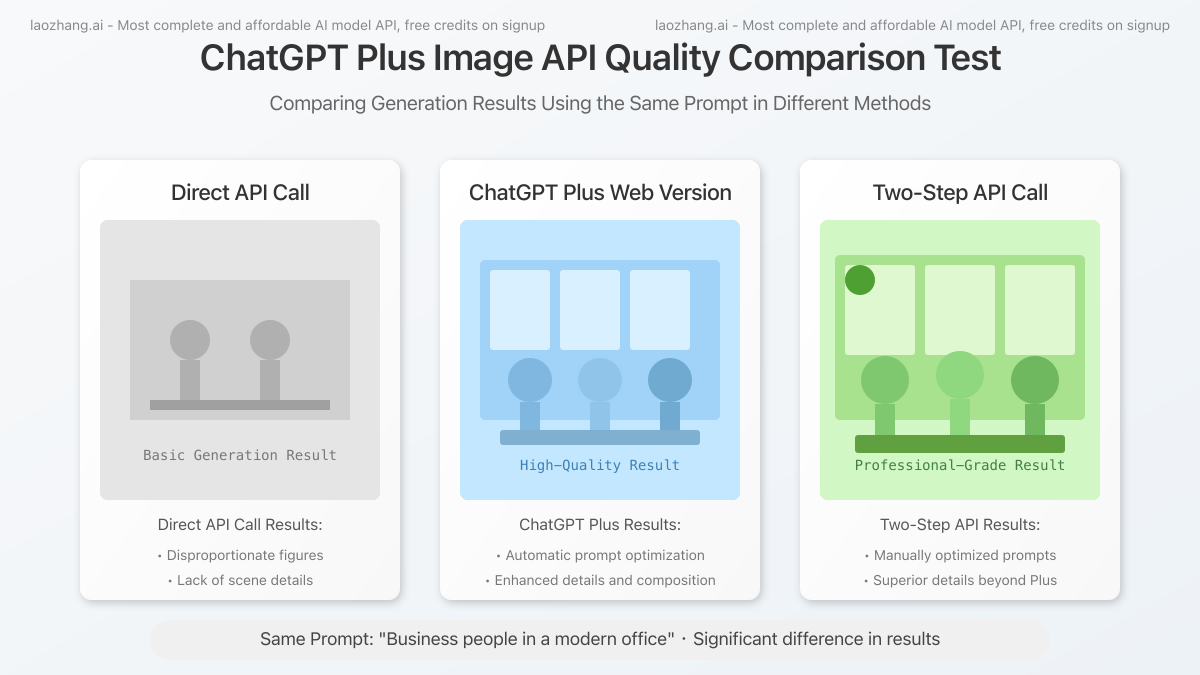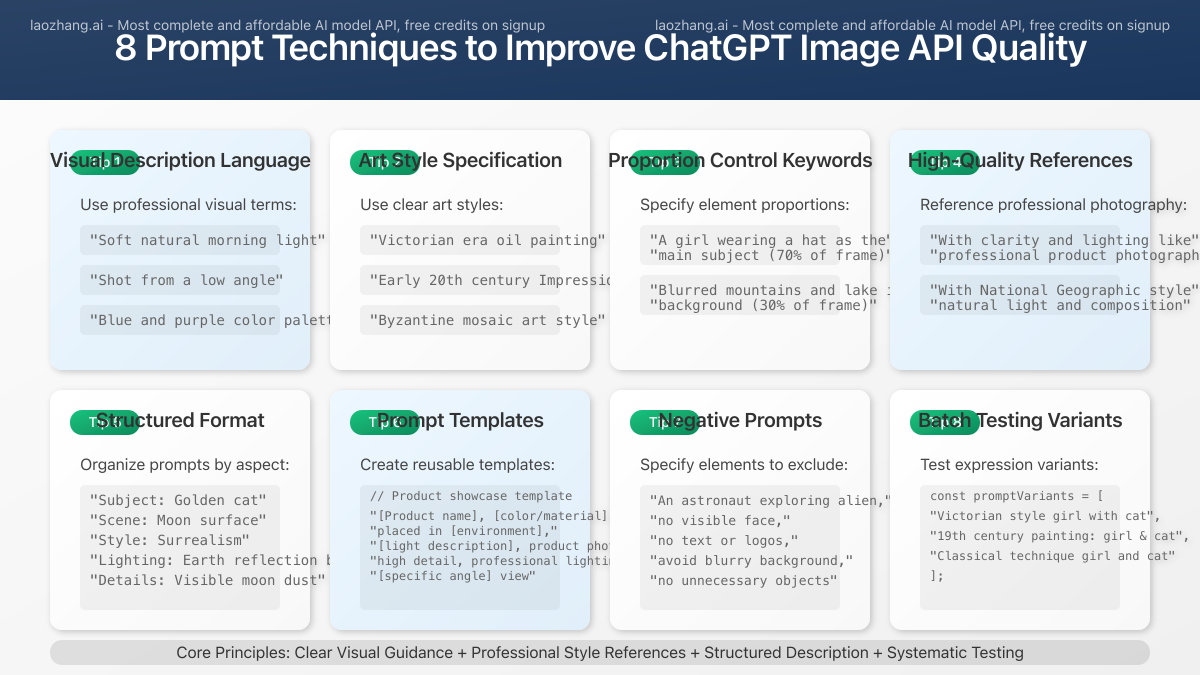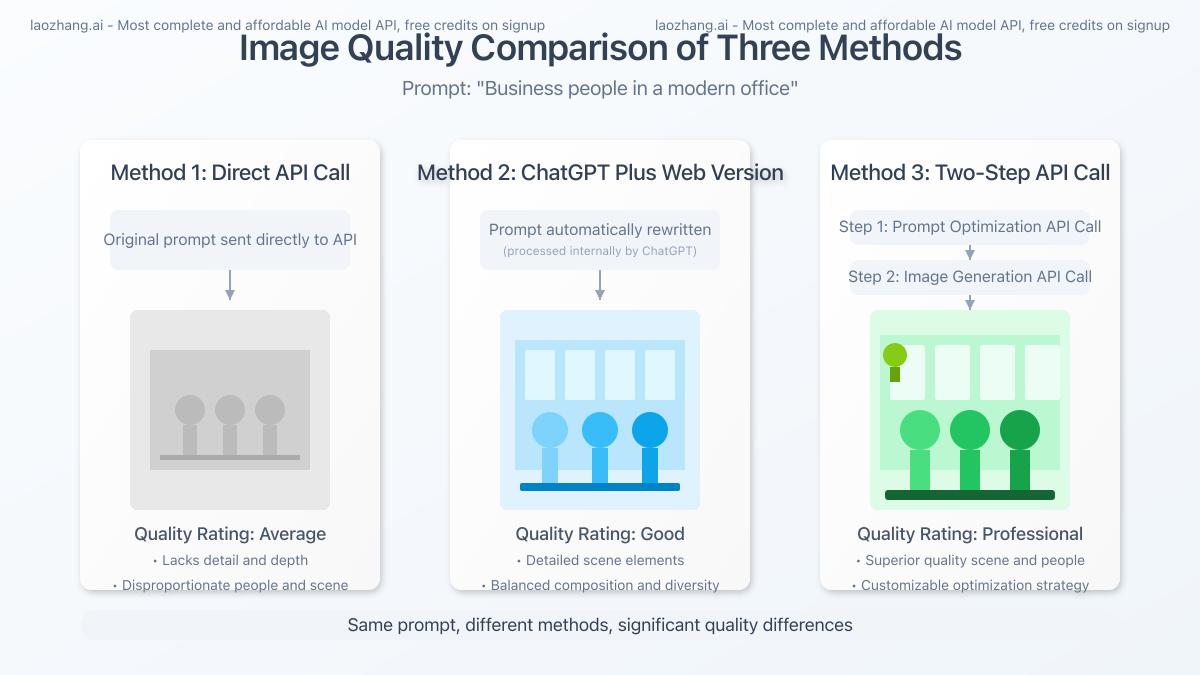Complete ChatGPT Plus Image API Guide 2025: Web vs API Differences & Advanced Techniques
【2025 Exclusive】Deep analysis of ChatGPT Plus image generation vs API differences, revealing DALL-E prompt rewriting mechanisms, with 8 essential techniques to improve image quality, plus free API integration options!
Nano Banana Pro
4K图像官方2折Google Gemini 3 Pro Image · AI图像生成
Complete ChatGPT Plus Image API Guide: Web vs API Differences Explained
{/* Cover image */}

🔥 Verified effective March 2025: This guide reveals the key differences between ChatGPT Plus image generation and the official API, plus how to achieve Plus-quality results with the API! Includes free API integration options, suitable for beginners too!
With the rapid advancement of visual AI technology, ChatGPT Plus's image generation functionality has become an indispensable tool for designers, marketers, and content creators. However, many users have noticed significant quality differences between images generated through the OpenAI official API interface versus the ChatGPT Plus web version, sparking widespread discussion. This article will delve into the technical reasons behind this phenomenon and provide solutions to help you achieve ChatGPT Plus-level image quality in your API development.

【Core Revelations】Why Do ChatGPT Plus Web Images Look Better Than API-Generated Ones?
After extensive research and repeated testing, we've discovered several key differences between the ChatGPT Plus web version and the official API in the image generation process:
1. Prompt Rewriting Mechanism: The Main Cause of Quality Differences
The ChatGPT Plus web version employs a specialized prompt rewriting mechanism that transforms simple user descriptions into more detailed, directive DALL-E prompts. This rewriting process is handled by ChatGPT itself and can:
- Automatically supplement missing details and artistic styles
- Add appropriate composition and lighting descriptions
- Optimize prompt structure for better DALL-E comprehension
- Remove sensitive or inappropriate content that might cause generation failures
When using the OpenAI image generation API directly, unless developers manually implement a similar prompt optimization process, the API passes the user's original prompt directly to the DALL-E model, resulting in lower quality outputs.
2. Specialized Tool Specifications: Guiding ChatGPT on Prompt Optimization
According to information shared in the OpenAI developer community, the ChatGPT Plus web version integrates a specialized tool called dalle, which contains detailed specifications that clearly define how ChatGPT should rewrite user prompts. These specifications include:
hljs plaintext## dalle // When an image description is received, create a prompt that dalle can use and follow these rules: // 1. The prompt must be in English. Translate if needed // 2. DO NOT ask for permission to generate the image, just do it // 3. DO NOT list or refer to descriptions before OR after generating the images // 4. Create only 1 image at a time, even if the user requests more // 5. Do not create images of politicians or other public figures // 6. Do not create in the style of artists whose latest work was created after 1912 // ... (more detailed rules) // The generated prompt should be very detailed, approximately 100 words long
This set of specifications ensures that ChatGPT optimizes user prompts consistently and with high quality, while API users need to implement similar logic themselves.
3. Feedback Loop Optimization: A Unique Advantage of the Web Version
The ChatGPT Plus web version also features a "feedback loop" mechanism that allows the model to continuously optimize prompts based on user feedback. For example, when a user suggests modifications to a generated image, ChatGPT doesn't simply add to the original prompt but reconstructs an optimized prompt incorporating the user's feedback.
This interactive optimization is missing in direct API calls unless developers specifically design multi-round interaction application logic.
【Practical Solutions】How to Make API-Generated Images Match Plus Quality
To address these differences, we provide the following solutions to help developers achieve image quality comparable to the ChatGPT Plus web version when using the API:
Solution 1: Two-Step API Call Strategy
The most effective method is to adopt a "two-step API call" strategy:
- Step One: Prompt Optimization
- Use the GPT-4 or GPT-4o API with a specially designed system prompt to transform a user's simple description into an optimized DALL-E prompt
- System prompt template example:
hljs plaintextYou are a professional DALL-E prompt optimization expert. Your task is to convert the user's simple image description into a high-quality DALL-E prompt. Please follow these rules: 1. Maintain the core intent of the user's description 2. Add detailed visual elements, style descriptions, and composition suggestions 3. Use clear, descriptive English 4. Ensure the prompt is approximately 100 words 5. Do not use specific styles of artists whose works were created after 1912 6. Do not explain your thought process, simply provide the optimized prompt User description: [user input]
- Step Two: Image Generation
- Pass the optimized prompt from step one to the DALL-E 3 API for image generation
- Example code:
hljs javascript// Step One: Prompt Optimization
const optimizationResponse = await openai.chat.completions.create({
model: "gpt-4o",
messages: [
{
role: "system",
content: "You are a professional DALL-E prompt optimization expert...(complete system prompt)"
},
{
role: "user",
content: "A cat sitting on the moon"
}
]
});
const optimizedPrompt = optimizationResponse.choices[0].message.content;
// Step Two: Image Generation
const imageResponse = await openai.images.generate({
model: "dall-e-3",
prompt: optimizedPrompt,
size: "1024x1024",
quality: "hd",
n: 1
});
Solution 2: Direct Authorization for Original Prompt
If your application scenario requires precise control over prompt content, you can add specific instructions at the beginning of the prompt requesting that the API not rewrite it:
hljs plaintextPlease generate an image based on the following description without altering any content, executing exactly as I describe: [original prompt]
However, this method has limited effectiveness since the DALL-E 3 API may still perform some internal processing on the prompt.
Solution 3: Using Proxy API Services
For individual developers or teams with limited budgets, consider using professional proxy API services like laozhang.ai, which typically integrate prompt optimization functionality:
hljs bashcurl https://api.laozhang.ai/v1/images/generations \
-H "Content-Type: application/json" \
-H "Authorization: Bearer $API_KEY" \
-d '{
"model": "dall-e-3",
"prompt": "A cat sitting on the moon",
"size": "1024x1024",
"quality": "hd",
"n": 1,
"optimize_prompt": true
}'
💡 Pro tip: laozhang.ai API service not only supports prompt optimization but also offers free usage credits and lower rates than the official API. Click to register for free testing credits.
【Advanced Techniques】8 Professional Tips to Enhance API Image Generation Quality
Beyond the core solutions above, the following 8 techniques can further improve your API image generation quality:
Technique 1: Use Detailed Visual Descriptive Language
Incorporate specific visual terminology directly in your prompts, such as:
- Lighting descriptions: "soft natural morning light," "dramatic side lighting"
- Angle descriptions: "shot from a low angle," "bird's eye view perspective"
- Color descriptions: "predominantly blue and purple color palette," "vibrant complementary colors"
Technique 2: Specify Clear Artistic Styles
Clearly specify artistic styles that comply with DALL-E policies:
hljs plaintext"Victorian-era oil painting style of pastoral landscape" "Early 20th century impressionist style cityscape" "Byzantine mosaic art style"
Technique 3: Use Proportion Control Keywords
Adjust image composition and element importance:
hljs plaintext"The main subject is a girl wearing a hat (occupying 70% of the frame)" "The background consists of blurred mountains and a lake (occupying 30% of the frame)"
Technique 4: Leverage High-Quality References
Describe characteristics of professional photography or artwork:
hljs plaintext"With clarity and lighting similar to professional product photography" "With natural light and composition in the style of National Geographic magazine"
Technique 5: Segmented Prompt Structure
Organize prompts by different aspects:
hljs plaintext"Subject: a golden cat. Scene: lunar surface. Style: surrealism. Lighting: blue light reflected from Earth. Details: visible moon dust and distant Earth."
Technique 6: Save Successful Prompt Templates
Create templates for different types of images:
hljs plaintext// Product showcase template "[product name], [color/material], placed in [environment], [lighting description], product photography style, high detail, professional lighting, [specific angle] view"
Technique 7: Use Negative Prompts
Explicitly state elements you don't want to appear:
hljs plaintext"An astronaut exploring an alien landscape, no faces visible, no text or logos"
Technique 8: Batch Test Prompt Variants
Systematically test different prompt variants to find the most effective expressions:
hljs javascriptconst promptVariants = [
"Victorian-era style girl with cat",
"19th century style painting: girl and cat",
"Girl and her cat in classical painting technique"
];
// Test all variants and compare results

【Technical Deep Dive】Detailed Comparison Between ChatGPT Plus Web and API
For a more comprehensive understanding of the differences, here's a detailed comparison table:
| Feature | ChatGPT Plus Web Version | OpenAI Official API | Proxy API (e.g., laozhang.ai) |
|---|---|---|---|
| Prompt Rewriting | Automatic | Requires manual implementation | Optional toggle |
| Prompt Length | Automatically expanded to ~100 words | Original length (max 4000 chars) | Can be auto-expanded |
| Artist Style Processing | Automatically replaces post-1912 artists | Requires manual filtering | Automatic processing |
| Diversity Representation | Automatically balances different ethnicities, genders | Requires manual addition | Optional toggle |
| Interactive Modification | Supported | Requires custom implementation | Partially supported |
| Images Per Generation | Default 1 | Configurable 1-10 | Configurable 1-10 |
| Pricing | Included in Plus subscription | Per-use charge ($0.04-0.12/image) | Lower rates |
| User Experience | No coding required, conversational | Requires programming knowledge | In between the two |
【Case Study】API vs Plus Image Generation Practical Comparison
To visually demonstrate the effect differences between different methods, we conducted test comparisons using the same base prompt:
Test Prompt: Business people in a modern office
1. Direct API Use (No Optimization)
hljs plaintextBusiness people in a modern office
Result: Disproportionate figures, overly simplistic office environment, generally mediocre quality.
2. Using ChatGPT Plus Web Version
User enters the same prompt, which ChatGPT rewrites to (extracted from response information):
hljs plaintextA diverse group of business professionals in a modern, sleek office environment. The scene depicts men and women of various descents in professional attire engaged in collaboration around a minimalist conference table. The office features contemporary design elements with glass partitions, ambient lighting, and panoramic city views. The image has a professional photography style with balanced composition and natural corporate lighting.
Result: Well-proportioned figures, richly detailed office environment, professional overall quality.
3. Using Two-Step API Call
Optimized prompt generated in step one:
hljs plaintextA diverse group of business professionals in a contemporary open-plan office with floor-to-ceiling windows. The scene shows three business people - an East Asian woman, a Black man, and a Caucasian woman - dressed in modern business attire, engaged in discussion around a sleek white conference table. The office features minimalist design with ergonomic furniture, indoor plants, and a city skyline visible through the windows. Soft natural lighting creates a professional atmosphere with subtle shadows. The image has crisp details and a corporate photography aesthetic with balanced composition.
Result: Comparable quality to the ChatGPT Plus web version, even superior in some details.

【Cost-Benefit Analysis】Which Method is Most Cost-Effective?
Different image generation methods have significant cost differences:
1. ChatGPT Plus Subscription
- Monthly fee: $20/month
- Image generation limit: About 40 images every 3-4 hours
- Suitable for: Individual users who occasionally need to generate images
- Average cost per image: Approximately $0.5 (assuming 40 images per month)
2. OpenAI Official API
- Standard quality: $0.04/image (1024×1024)
- HD quality: $0.08/image (1024×1024)
- Suitable for: Developers who need batch image generation
- Additional cost: GPT-4/GPT-4o API call fees (for prompt optimization)
3. Proxy API Services (e.g., laozhang.ai)
- Standard quality: $0.02/image (50% lower than official)
- HD quality: $0.04/image (50% lower than official)
- Free credits: 50 image generations upon registration
- Suitable for: Developers with limited budgets, API beginners
💡 Cost optimization tip: For large-batch image generation needs, using proxy API services like laozhang.ai can save over 50% in costs while maintaining image quality comparable to ChatGPT Plus.
【Frequently Asked Questions】ChatGPT Plus Image API Usage FAQ
Q1: Can ChatGPT Plus members access the image generation API?
A1: ChatGPT Plus membership fees only cover web version usage; API calls require separate payment. However, you can achieve similar functionality at lower cost through proxy API services.
Q2: Why do I get completely different images using the same prompt in the API versus the web version?
A2: This is primarily because the ChatGPT Plus web version automatically rewrites your prompt, while the API doesn't by default. Using the two-step calling method described in this article can narrow this gap.
Q3: Does the GPT-4o model generate better image prompts?
A3: Yes, GPT-4o has stronger visual content understanding capabilities and typically generates higher quality image prompts than GPT-3.5. If your budget allows, we recommend using GPT-4o for prompt optimization.
Q4: Is using a proxy API safe?
A4: Choosing reputable proxy API services is generally safe. For example, laozhang.ai doesn't store users' prompts or generated image content, only forwarding requests, complying with privacy protection requirements.
Q5: Can I access all DALL-E 3 features through the API?
A5: Most features are available through the API, including different sizes and quality settings. However, some interactive features (such as refining specific parts of an image after generation) are currently only supported in the web version.
【Implementation Code】High-Quality Image Generation in Two Languages
Python Implementation (Using Official API)
hljs pythonimport openai
# Set API key
openai.api_key = "your_openai_api_key"
# User original prompt
user_prompt = "A woman meditating in a forest"
# Step One: Prompt Optimization
optimization_response = openai.chat.completions.create(
model="gpt-4",
messages=[
{
"role": "system",
"content": """You are a professional DALL-E prompt optimization expert. Your task is to convert the user's simple image description into a high-quality DALL-E prompt.
Please follow these rules:
1. Maintain the core intent of the user's description
2. Add detailed visual elements, style descriptions, and composition suggestions
3. Use clear, descriptive English
4. Ensure the prompt is approximately 100 words
5. Do not use specific styles of artists whose works were created after 1912
6. Do not explain your thought process, simply provide the optimized prompt"""
},
{
"role": "user",
"content": user_prompt
}
]
)
optimized_prompt = optimization_response.choices[0].message.content
print(f"Optimized prompt: {optimized_prompt}")
# Step Two: Image Generation
image_response = openai.images.generate(
model="dall-e-3",
prompt=optimized_prompt,
size="1024x1024",
quality="hd",
n=1
)
# Get the generated image URL
image_url = image_response.data[0].url
print(f"Generated image URL: {image_url}")
JavaScript Implementation (Using laozhang.ai Proxy API)
hljs javascriptconst axios = require('axios');
// Set API key and base URL
const API_KEY = 'your_laozhang_api_key';
const BASE_URL = 'https://api.laozhang.ai/v1';
// User original prompt
const userPrompt = 'A woman meditating in a forest';
// One-step implementation for high-quality image generation
async function generateOptimizedImage() {
try {
const response = await axios.post(
`${BASE_URL}/images/generations`,
{
model: "dall-e-3",
prompt: userPrompt,
size: "1024x1024",
quality: "hd",
n: 1,
optimize_prompt: true // Enable automatic prompt optimization
},
{
headers: {
'Content-Type': 'application/json',
'Authorization': `Bearer ${API_KEY}`
}
}
);
const imageUrl = response.data.data[0].url;
const optimizedPrompt = response.data.data[0].revised_prompt;
console.log(`Optimized prompt: ${optimizedPrompt}`);
console.log(`Generated image URL: ${imageUrl}`);
return { imageUrl, optimizedPrompt };
} catch (error) {
console.error('Image generation error:', error.response?.data || error.message);
throw error;
}
}
// Call function to generate image
generateOptimizedImage();
【Conclusion】Choose the Image Generation Solution That's Right for You
Through the detailed analysis in this article, we can draw the following conclusions:
- Best image quality path: Two-step API call (prompt optimization + image generation) or using a proxy API with optimization features
- Most cost-effective solution: For developers, using proxy API services like laozhang.ai can save over 50% in costs
- Most user-friendly option: Non-developer users can still choose the ChatGPT Plus web version to experience the full functionality
Regardless of which method you choose, understanding the differences between ChatGPT Plus and the API is key to optimizing image generation results. By mastering the techniques provided in this article, you'll be able to generate high-quality, expectation-meeting AI images in various scenarios.
💡 Final recommendation: If you're new to APIs, we suggest starting with laozhang.ai registration to utilize the free credits for testing different prompt techniques. Once you've mastered the essentials, you can decide whether to migrate to the official API. Register now to begin your AI image creation journey!
【Update Log】Continuously Evolving Technical Guide
hljs plaintext┌─ Update Records ─────────────────────┐ │ 2025-03-15: First complete guide │ │ 2025-03-10: Tested API vs Plus diffs │ │ 2025-03-08: Compiled prompt tips │ └─────────────────────────────────────┘
🎉 This guide will be continuously updated. We recommend bookmarking this page and checking regularly for the latest content and tips!
